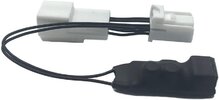MJDaniels
New Member
Newbie questions here,
To minimize threading of dash cam power cabling, I hear many are using the powered circuit that a rear-view mirror in their vehicle is powered by. They install a commercially available splitter style 3-way adapter like the one pictured below, with one leg connected to the vehicle’s powered circuit, another leg then connected to a rear-view mirror that is normally powered, and the 3rd leg is an open USB connector for use in providing power for the dash cam. This is instead of threading a cable to the dash cam from a fuse block or a cigarette lighter. By doing this, they bring a power source and connector close to the dash cam, where they can then connect the camera with a short USB cable.
This seems efficient and makes for a nice, neat package + no threading of cable. However, this means that the USB connector is then 12V. I'm not sure how feasible this method is, there is no real space for a 12V-5V step-down device, and I think most dash cams are not dual voltage and want only 5V to operate.
My questions:
- If you were to apply 12V directly to the dash cam, wouldn’t you fry the dash cam?
- Are there dash cams available that will take 12V input directly into the unit?
-What am I missing? Does anyone have any experience with this that they would be willing to share?
Thanks in advance.

To minimize threading of dash cam power cabling, I hear many are using the powered circuit that a rear-view mirror in their vehicle is powered by. They install a commercially available splitter style 3-way adapter like the one pictured below, with one leg connected to the vehicle’s powered circuit, another leg then connected to a rear-view mirror that is normally powered, and the 3rd leg is an open USB connector for use in providing power for the dash cam. This is instead of threading a cable to the dash cam from a fuse block or a cigarette lighter. By doing this, they bring a power source and connector close to the dash cam, where they can then connect the camera with a short USB cable.
This seems efficient and makes for a nice, neat package + no threading of cable. However, this means that the USB connector is then 12V. I'm not sure how feasible this method is, there is no real space for a 12V-5V step-down device, and I think most dash cams are not dual voltage and want only 5V to operate.
My questions:
- If you were to apply 12V directly to the dash cam, wouldn’t you fry the dash cam?
- Are there dash cams available that will take 12V input directly into the unit?
-What am I missing? Does anyone have any experience with this that they would be willing to share?
Thanks in advance.


